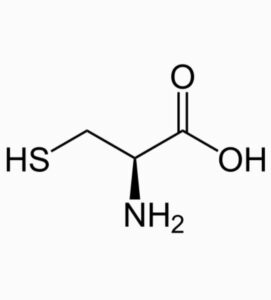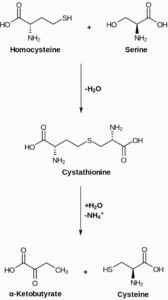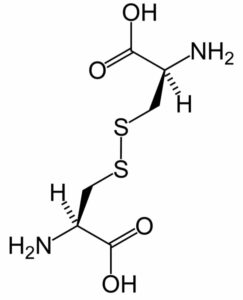In this article we are going to study various facts related to cysteine structure in detail.
Cysteine is said to be a non essential amino acid that contains sulfur. The importance of cysteine is that it is very important synthesis of protein, various metabolic related functions and detoxification. It’s IUPAC name is (2R)-2-amino-3-sulfanypropanoic acid.
Facts about cysteine structure:
Cysteine is seen to exist in zwitterion form. It was first discovered by Louis N.V and Pierre J.R in the year 1806. In appearance it is white crystalline (powder) and has a melting point of 240 degree Celsius.
Discussing about its structure in brief, it has one carbon atom which is an alpha carbon to which a alpha carboxylic acid and alpha amino group is attached. As we can see in the diagram there is one hydrogen that is attached to alpha carbon. The NH3 group is seen to be common in almost all amino groups.

Image credit: Wikipedia
The cysteine structure has thiol side chain (side group -R) which is often seen to participate in the enzymatic kind of reactions as nucleophile. The only difference that exists in the structure of amino acids is the side chin or side group. UGC and UGU are the amino acids that code for cysteine. Most of the times the structure of cysteine is L-cysteine.
Preparing cysteine by the method of biosynthesis:

The concept of cysteine and cystine:
It has been observed that cysteine is not stable in air. Hence usually in proteins it is seen to exist as cystine (it forms a disulfide bond in between residues of 2 cysteine).
It is very carefully protected in protein to enhance its stabilizing activity of structures of high order in a protein. Cysteine is considered as a very powerful antioxidant and has anti-aging properties. But one problem with this is that cysteine tends to be absorbed in cells and there it is unable to exhibit the antioxidant property. Hence to overcome this limitation NAC (N-acetyl cysteine) is being used. When cysteine is used as food additive, the E number that it has is E920.
Product of cysteine is cystine when 2 cysteine come in close proximity with each other two sulfur donate hydrogen and form disulfide bond, this is how a cystine molecule is formed. But cysteine and cystine differ in properties.It’s molecular weight is 121.16 g/mol. In the below section we’ll get a clear view on cysteine structure and its functionality.
Cystine
It has been observed that cystine is less soluble in comparison to cysteine. Seen to be more stable and is formed from the process of oxidation of the cysteine. Considered to be semi essential and can be essential amino acid at times. It is not absorbed easily by body.

Cysteine
It has been observed that cystine is more soluble in comparison to cystine. Seen to be less stable and is formed from the amino acids methionine and serin. Considered to be non essential amino acid. It is easily absorbed body. It is seen to be soluble in water and also dissolves in ethanol at a temperature around 19-20 degree Celsius.
Sources of cysteine:
Animal source: Meat, fish, egg, etc.
Vegetarian source: sprouts, lentils, garlic, etc.
Conjugation facts about cysteine structure:
Conjugation based on cysteine target the sulfur (thiol) atoms (in side chain) for the nucleophilic type of reactions such as with Michael acceptor like maleimides or it can also be electrophiles like haloacetamides. The chemistry of thiol and maleimide is of great interest as the reactions take place at both acidic as well as basic type of conditions (pH 6 to 8).
Cysteine reactions in brief:
Carboxymethylation (Iodoacetic acid)

Carboxyamidomethylation (Iodoacetamide)

Addition (N-ethylmaleimide)

This is Sania Jakati from Goa. I am an aspiring chemist pursuing my post graduation in organic chemistry. I believe education is the key element that moulds you into a great human being both mentally and physically. I’m glad to be a member of scintillating branch of chemistry and will try my best to contribute whatever I can from my side and Lambdageeks is the best platform where I can share as well as gain knowledge at the same time.